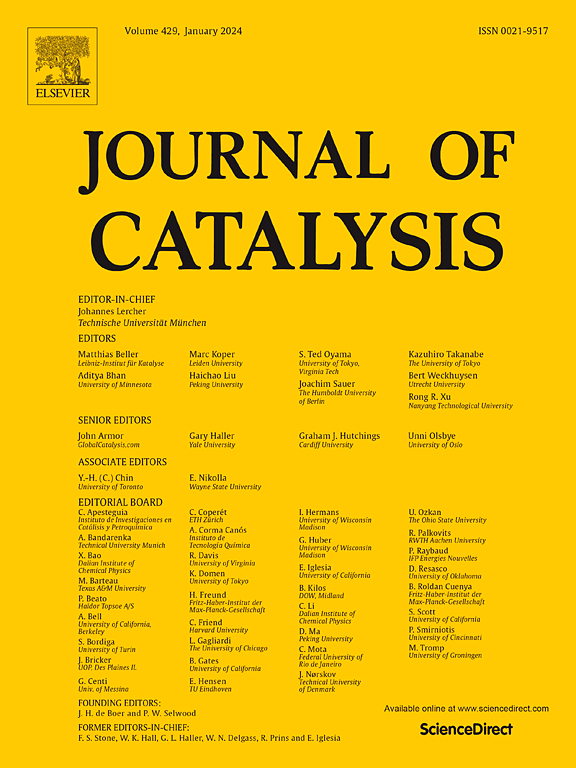层状多孔共轭聚合物增强PET-RAFT聚合的面向结构优化
IF 6.5
1区 化学
Q2 CHEMISTRY, PHYSICAL
引用次数: 0
摘要
分层多孔材料因其大表面积和可调节的孔隙结构而受到高度重视,使其成为光诱导电子转移-可逆加成-破碎链转移(PET-RAFT)聚合的非均相催化剂。然而,孔结构对催化性能的具体影响尚不清楚。在本研究中,采用硅硬模板法合成了分层多孔共轭有机聚合物(cop),并将其用作PET-RAFT聚合的光催化剂。在白光LED照射下,系统研究了模板尺寸和浓度对孔结构和光催化性能的影响。其中,浓度为60 mg/mL、粒径为300 nm的二氧化硅模板制备的COP平均孔径为6.91 nm,表现出最佳的光催化性能。在此条件下聚合速度是对照的2.5倍。微孔、中孔和大孔之间的协同作用通过增加表面面积、促进传质和提高载流子迁移率来提高光催化效率。光谱和电化学分析进一步表明,优化后的孔隙结构通过促进电荷的分离和迁移,显著增强了载流子动力学。这种结构调制有效地减少了电荷重组,从而提高了PET-RAFT聚合的光催化效率。这些发现为合理设计先进PET-RAFT体系的多孔光催化剂提供了有价值的见解。本文章由计算机程序翻译,如有差异,请以英文原文为准。

Structure-oriented optimization of hierarchical porous conjugated polymers for enhanced PET-RAFT polymerization
Hierarchically porous materials are highly valued for their large surface areas and tunable pore architectures, making them promising heterogeneous catalysts for photoinduced electron transfer-reversible addition-fragmentation chain transfer (PET-RAFT) polymerization. However, the specific influence of pore structure on catalytic performance remains poorly understood. In this study, hierarchically porous conjugated organic polymers (COPs) were synthesized using a silica hard-template method and employed as photocatalysts for PET-RAFT polymerization. Under white LED light irradiation, the effects of template size and concentration on pore structure and photocatalytic performance were systematically investigated. Notably, a silica template with a concentration of 60 mg/mL and a particle size of 300 nm produced a COP with an average pore size of 6.91 nm, which exhibited the best photocatalytic performance. The polymerization rate under these conditions was 2.5 times higher than that of the control. The synergy among micropores, mesopores, and macropores enhanced photocatalytic efficiency by increasing surface area, promoting mass transfer, and improving charge carrier mobility. Spectroscopic and electrochemical analyses further revealed that the optimized pore structure significantly enhances charge carrier dynamics by facilitating charge separation and migration. This structural modulation effectively reduces charge recombination, thereby improving the photocatalytic efficiency in PET-RAFT polymerization. These findings provide valuable insights into the rational design of porous photocatalysts for advanced PET-RAFT systems.
求助全文
通过发布文献求助,成功后即可免费获取论文全文。
去求助
来源期刊

Journal of Catalysis
工程技术-工程:化工
CiteScore
12.30
自引率
5.50%
发文量
447
审稿时长
31 days
期刊介绍:
The Journal of Catalysis publishes scholarly articles on both heterogeneous and homogeneous catalysis, covering a wide range of chemical transformations. These include various types of catalysis, such as those mediated by photons, plasmons, and electrons. The focus of the studies is to understand the relationship between catalytic function and the underlying chemical properties of surfaces and metal complexes.
The articles in the journal offer innovative concepts and explore the synthesis and kinetics of inorganic solids and homogeneous complexes. Furthermore, they discuss spectroscopic techniques for characterizing catalysts, investigate the interaction of probes and reacting species with catalysts, and employ theoretical methods.
The research presented in the journal should have direct relevance to the field of catalytic processes, addressing either fundamental aspects or applications of catalysis.
 求助内容:
求助内容: 应助结果提醒方式:
应助结果提醒方式:


